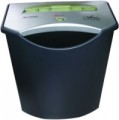Shredding Items
Types of media and materials that the shredder can utilize. Note that, by definition, all such devices are capable of working with paper documents, so paper is not mentioned in this paragraph (some models are generally
only compatible with paper and do not allow using other materials). However, shredders with the ability to utilize various additional items are more common — mainly
staplers,
paper clips,
credit cards and/or
CDs/DVDs. Here are the features of each of these options:
— Staples. An auxiliary function designed to ensure that stapled materials do not have to be separated before being loaded into the shredder. Allows you to significantly save time when utilizing of such materials, especially in large volumes; also provides a correct operation guarantee in case of accidental contact with the staples.
— Paper clips. Paper clips are removed much easier than staplers and there is no problem with them even with a large amount of documents. Therefore, this function is rather an insurance against getting such a clip into the device along with the document.
— Credit cards. The ability to recycle various plastic cards with magnetic media — credit cards, passes, etc. This feature at least prevents the illegal use of such cards, and with a high security level it allows you to
...keep the fact of the existence of a card in secret. Actually, the security level for such utilization is indicated in the generally accepted standard DIN 66399, as like as for paper, and there are seven of them:
- 1 — the card remains intact, its surface is mechanically damaged;
- 2 — the card is cut into pieces with an area of less than 2000 mm²;
- 3 — size of pieces less than 320 mm²;
- 4 — less than 160 mm²;
- 5 — less than 30 mm²;
- 6 — less than 10 mm²;
- 7 — less than 2.5 mm².
— CDs/DVDs. Ability to utilize optical discs, which can also store confidential information. For such media, DIN 66399 also provides 7 security levels:
- 1 — the disk is cut into pieces with an area of less than 2000 mm²;
- 2 — less than 800 mm²;
- 3 — less than 160 mm²
- 4 — less than 30 mm²;
- 5 — less than 10 mm²;
- 6 — less than 5 mm²;
- 7 — less than 0.2 mm².
Fragment sizes
The largest possible size of the fragments that come out from the shredder after being processed. However, it's told about fragments only in the case of using cross-cutting; for stripe cut models (see “Cut Style”), this item indicates the largest width of the stripes. The size of the fragments is directly related to the security level provided by the shredder; see the relevant paragraph above for details.
Gap Size
The gap size of the shredder is the opening where the utilization materials are placed. This indicator determines the maximum size of the material that the device can handle at one time, without the need to fold or cut the sheet. The common gap size for most office models is 220 – 230 mm — this allows you to easily work with the popular
A4 format(sheet width — 210 mm). But
for sheet A3, with a width of 297 mm, you will need at least 310 mm gap size.
Duty cycle
The duty cycle of the shredder is the maximum time that it can work without interruption.
Limit of operating time is due to the fact that the destruction of documents and other media is associated with quite significant loads on the electric motor and gear. This leads to strong heating, while the breaks allow the hardware of the shredder to cool down. Actually, there are models with the possibility of continuous operation, but they are expensive and not always really necessary; see "Features" for details.
In small shredders for domestic use, the work cycle is often only a few minutes, and among powerful professional devices there are values of
half an hour or more. Also note that in some models, shutdown after a full cycle is provided automatically due to overheating protection (see "Features"), however, the presence of such a system does not mean the presence of an automatic shutdown on time — it can only work with a critical increase of temperature.
Wastebin capacity
The volume of the waste bin that is filling with shredded materials after passing through the shredder. The larger it is, the less often you will have to empty the basket; at the same time, large containers increase both the weight and dimensions and the cost rate of the device. For comparison: the volume of a standard household bucket is about 10 liters, a shredder with a basket of such a capacity will have dimensions of about 35x30x15 cm and belongs to the entry level in terms of capacity.
Noise level
The maximum noise level produced by the shredder during operation. The lower this indicator, the quieter the device works and the more comfortable it is to use, the better it is suitable for conditions that require silence (for example, libraries or archives).
When assessing the noise level, it should be taken into account that the decibel is a non-linear measure unit, and noises with a difference of several decibels differ in volume by several times. For comparison, we can proceed from the following data: office shredders, positioned by the manufacturer as
"quiet", have a noise level of about 55 – 60 dB, which corresponds to the volume of ordinary human speech. 65 dB can be compared with a loud conversation, 70 – with a noisy street, 75 – with a scream, and there is practically no higher volume among office models.

